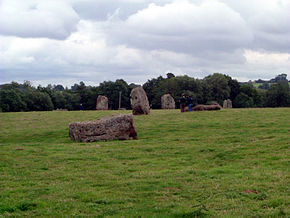Stanton Drew stone circles
 |
|
| Location | near Stanton Drew and Bristol |
|---|---|
| Region | Somerset, England |
| Coordinates | 51°22′04″N 2°34′31″W / 51.367797°N 2.575257°WCoordinates: 51°22′04″N 2°34′31″W / 51.367797°N 2.575257°W |
| Type | Henge monument |
| Site notes | |
| Condition | intact |
The Stanton Drew stone circles are just outside the village of Stanton Drew in the English county of Somerset. The largest stone circle is the Great Circle, 113 metres (371 ft) in diameter and the second largest stone circle in Britain (after Avebury); it is considered to be one of the largest Neolithic monuments to have been built. The date of construction is not known but is thought to be between 3000 and 2000 BCE which places it in the Late Neolithic to Early Bronze Age. It was made a scheduled monument in 1982.
The Great Circle was surrounded by a ditch and is accompanied by smaller stone circles to the north east and south west. There is also a group of three stones, known as The Cove, in the garden of the local pub. Slightly further from the Great Circle is a single stone, known as Hautville's Quoit. Some of the stones are still vertical, but the majority are now recumbent and some are no longer present.
The stone circles have been studied since John Aubrey's visit in 1664 with some excavations of the site in the 18th century. In the late 20th and early 21st centuries geophysical surveys have confirmed the size of the stone circles and identified additional pits and postholes. The Cove has been shown to be around one thousand years older than the stone circles, so dating from 4000-3000 BCE. A variety of myths and legends about the stone circles have been recorded, including one about dancers at a celebration who have been turned to stone.
The most famous feature is the Great Circle, the second largest stone circle in Britain (after Avebury). The stone circle is 113 metres (371 ft) in diameter and probably consisted of 30 stones, of which 27 survive today. It was recorded by both John Aubrey in 1664 and William Stukeley in 1776. The Great Circle probably was surrounded by the ditch (approximately 135 metres (443 ft) outer diameter — now filled in) of a henge. The North East Circle is 30 metres (98 ft) in diameter and probably consisted of 10 or more stones, of which 8 survive today. The South West Circle is 43 metres (141 ft) in diameter, and has 12 stones surviving today. An avenue extends to the northeast of the Great Circle towards the River Chew and a second avenue meets it from the north eastern stone circle.
...
Wikipedia
